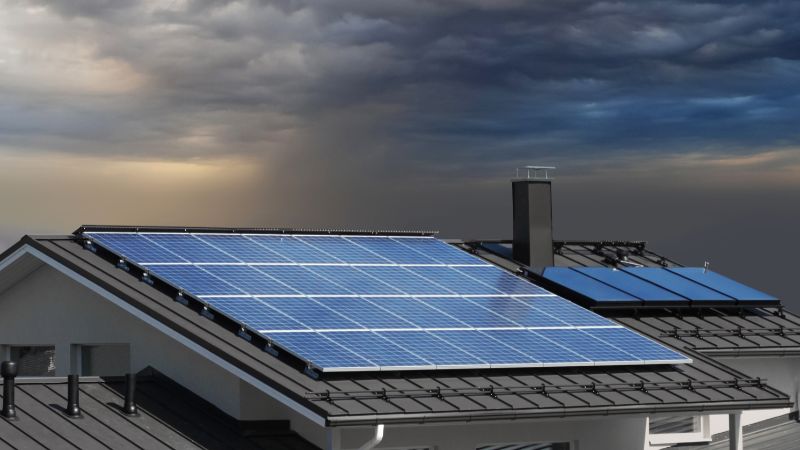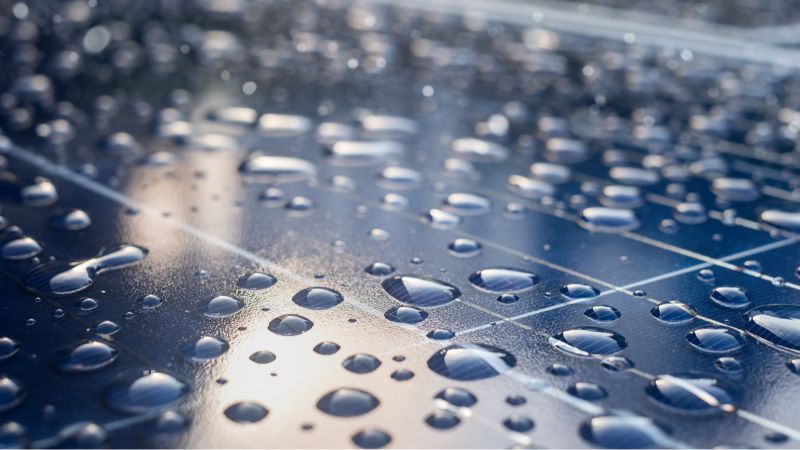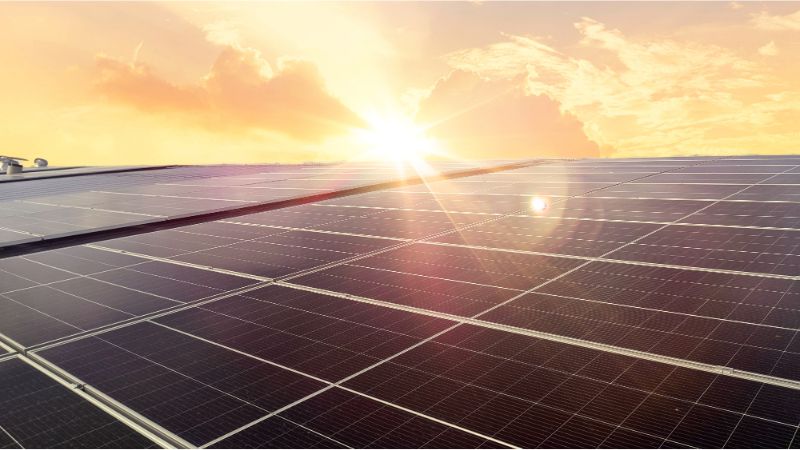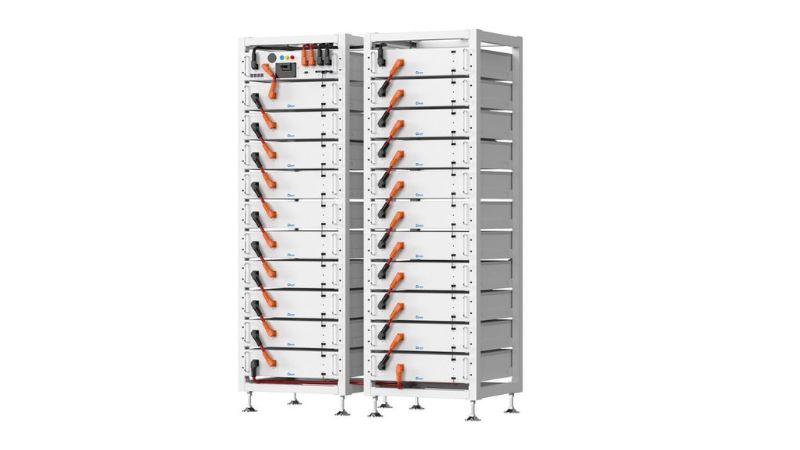Many people think solar panels need bright, direct sunlight to make power. You might be surprised to learn this isn’t true! Solar panels can generate electricity using both direct and indirect sunlight, which means they work even on cloudy days and in shaded areas.
Your solar panels use special materials like silicon to turn light particles (photons) into electricity. They don’t need heat from the sun – just light. This means your panels keep making power even when it’s cold or cloudy outside.
Think about getting a sunburn on a cloudy day – UV rays still reach you through the clouds. Solar panels work the same way. While they make the most power in direct sunlight, they can still create useful amounts of electricity in less-than-perfect conditions. You can count on your panels to generate power year-round, even during winter months or on rainy days.

Understanding Solar Panels
Solar panels can produce electricity from both direct and indirect sunlight through special materials and components working together. A properly designed solar system will generate power even in less-than-ideal conditions.
Basics of Solar Energy Capture
Your solar panels work by using photovoltaic cells to turn sunlight into electricity. These cells contain silicon that reacts when light hits them, creating an electric current.
You don’t need bright, direct sunlight for your panels to work. They can generate power on cloudy days and in shady conditions, though at reduced efficiency.
Your panels will still produce about 10-25% of their normal power output on cloudy days. Even rain and snow won’t stop them completely – though snow should be cleared off for best results.
Components of a Solar Panel
Your solar panel system has several key parts:
- Photovoltaic cells: Made of silicon layers that capture sunlight
- Glass casing: Protects the cells while letting light through
- Metal frame: Provides structure and weather protection
- Wiring: Carries the electric current where it needs to go
The cells are arranged in a grid pattern under the glass. Each cell connects to the others to combine their power output.
Most modern panels use monocrystalline or polycrystalline silicon cells. These materials are very good at capturing both direct and scattered light throughout the day.
How Solar Panels Operate in Different Conditions
Solar panels can work in many lighting conditions, not just bright sunshine. Your panels will produce power through clouds, shade, and different temperatures, though the amount varies based on the conditions.
Solar Panels on Cloudy Days

Your solar panels will still generate electricity on cloudy days, just at a lower rate. They capture both direct and indirect sunlight, which means they work even when clouds block the sun.
The power output typically drops to 10-25% of normal on very cloudy days. Light clouds or partial coverage will reduce output less.
Your panels can even produce some power during rain or snow, as long as there’s daylight. The rain can help by washing away dust and dirt that blocks sunlight.
Temperature Effects on Performance
Solar panels actually work better in cool temperatures than hot ones. Cool, sunny days are ideal for maximum power production.
For every degree above 77°F (25°C), your panels lose about 0.5% efficiency. This means a very hot 95°F day could reduce output by up to 9%.
Cold weather helps panels work more efficiently, but snow coverage will block light and stop power generation until it melts or is removed.
Peak Hours and Power Output
Your panels produce the most power during peak sun hours – typically 4-6 hours centered around midday when the sun is highest.
Power output follows this general pattern:
- Early morning: Low production
- Mid-morning to early afternoon: Peak production
- Late afternoon: Declining production
- Night: No production
Positioning your panels at the right angle helps capture maximum sunlight during peak hours. South-facing panels in the Northern Hemisphere usually work best.
Solar Energy Storage
Solar panels keep working even when the sun isn’t shining through smart storage solutions that make sure you have power day and night.
Solar Batteries and Their Role
A solar battery storage system holds extra power your panels create during sunny times. These batteries let you use stored energy when your panels aren’t making electricity, like at night or on very cloudy days.
Modern solar batteries come in different sizes to match your needs. A typical home battery can power your house for 4-12 hours, depending on how much electricity you use.
The main benefits of solar batteries include:
- Backup power during outages
- Lower electric bills
- Energy independence
- Less reliance on the power grid
Net Metering Explained
Net metering connects your solar system to the power grid. It acts like a giant battery that stores extra energy your panels make.
When your panels produce more power than you need, that energy goes to the grid. Your electric meter runs backward, giving you credits.
You can use these credits later when your panels aren’t making enough power. This system helps you:
- Save money on electric bills
- Get value from extra solar energy
- Stay powered at night
The power company becomes your backup system, eliminating the need for expensive batteries if you don’t want them.
Energy Storage Solutions: The Role of Deye ESS Batteries
To maximize the benefits of solar energy, you’ll need a reliable energy storage system. Deye ESS batteries are an excellent choice for homeowners looking to enhance their solar panel systems. These batteries store excess energy generated by your solar panels, allowing you to use when necessary.
With Deye ESS batteries, you can enjoy several advantages:
- Backup Power During Outages: Keep your essential appliances running even when the grid goes down.
- Lower Electric Bills: Utilize stored energy to reduce reliance on the grid and save on electricity costs.
- Energy Independence: Achieve greater self-sufficiency by relying on your solar energy system.
By pairing your solar panels with Deye ESS batteries, you can ensure a continuous power supply, making your solar energy system even more efficient and reliable.
Solar Panels During Non-Daylight Hours
Solar panels can still provide power when the sun isn’t shining through battery storage and grid connections. The cells themselves stop producing electricity after sunset, but smart energy management keeps your lights on.
Can Solar Panels Generate Power at Night?
Solar panels don’t generate new electricity at night. The photovoltaic cells need light to create an electric current.
Your home can still use solar energy after dark through two main methods:
- Battery storage: Extra power collected during the day is stored for nighttime use
- Grid connection: Excess daytime energy earns credits from power companies that you can use at night
Most modern solar setups include one or both of these solutions. Your stored solar power works just like regular electricity for running appliances and lights.
Effectiveness of Solar Panels under Moonlight
Moonlight is actually reflected sunlight, but it’s too weak to create usable electricity in solar panels. The amount of light reaching panels at night is less than 0.1% of daytime levels.
Your panels won’t charge batteries or power your home using moonlight alone. Even the brightest full moon doesn’t provide enough energy to generate measurable electricity.
The good news is that panels work well in indirect light during the day. Cloud cover, light rain, and partial shade still allow your system to produce power at reduced levels.
Maximizing Solar Panel Efficiency
Solar panels can work effectively in many weather conditions with the right setup and technology. Good panel placement and newer technology help you get the most power from your system.
Managing Solar Panels in Cloudy Weather
Your solar panels can still produce power on cloudy days, though at reduced levels. Most panels generate 10-25% of their normal output during overcast conditions.
Rain can actually help your panels work better by washing away dust and debris. The panels will still capture scattered light on rainy days.
Snow doesn’t automatically stop power generation. Many panels are installed at angles that let snow slide off. The white surface can even reflect extra light onto your panels.
Tips for cloudy conditions:
- Install panels at optimal angles
- Keep panels clean and free of debris
- Consider adding extra panels to make up for reduced output
- Use power storage systems for backup
Technological Advances in Solar
Modern solar panels are more efficient than ever. Monocrystalline panels can convert up to 23% of sunlight into electricity, while newer designs push even higher.
Recent innovations include:
- Bifacial panels that capture light from both sides
- Anti-reflective coatings for better light absorption
- Smart tracking systems that follow the sun
- Improved energy storage solutions
Advanced materials help panels work better in low-light conditions. Some newer panels can generate power from artificial light or on very cloudy days.
Panel efficiency keeps improving each year. The latest designs are smaller but produce more power than older models.
Alternative Operating Scenarios for Solar Panels
Solar panels can still generate electricity in less-than-ideal conditions through both indirect sunlight and artificial light sources. The panels work by converting any available light into power, not just direct sunshine.

Can Solar Panels Function in the Shade?
Your solar panels continue working even in shaded conditions, though at reduced efficiency. They capture both direct and indirect sunlight to produce electricity.
Panels typically generate 10-25% of their normal output on cloudy days. Rain and snow don’t stop power generation completely – the panels can still capture scattered light.
The amount of power produced depends on how dense the shade is. Light shade from trees might reduce output by 20-30%, while heavy shade from buildings could cut production by 50-75%.
Solar Panels and Artificial Light
Your panels can generate small amounts of electricity from artificial light sources like LED bulbs and fluorescent lighting. The output is much lower than what you’d get from sunlight.
Indoor lighting generally produces very little power – often less than 1% of what the same panel would generate in direct sun. This tiny amount isn’t enough to power your home.
The best use of artificial light generation is for small devices like calculators or garden lights. These need minimal power to operate and can function with the reduced output.
Real-World Applications and Considerations
Solar panels can keep working in many different weather conditions and situations, making them a practical choice for your home or business. They provide reliable power even during challenging times.
Solar Energy in Power Outages
Your solar panels can be a lifeline during blackouts when paired with battery storage. The batteries store extra energy produced on sunny days for use at night or during outages.
Modern solar systems automatically switch to battery power when the grid goes down. This means your essential appliances and lights stay running.
Your panels will still generate some power even in cloudy conditions during an outage. They typically produce 10-25% of their normal output on overcast days.
Renewable Energy Impact
Your solar installation helps create a more stable and clean energy future. By generating power from sunlight, you reduce reliance on fossil fuels and lower your carbon footprint.
Solar panels work effectively in many climates – even in rainy Seattle or snowy Boston. While snow can temporarily block panels, it usually melts quickly due to the panels’ dark surface and tilt.
The technology keeps improving. Newer panels can generate useful amounts of power even in partial shade or indirect light.
You’ll see the biggest benefits by positioning your panels to catch maximum sunlight and keeping them clean. A professional installer can help determine the ideal setup for your location.
